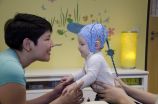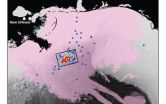INFORMATION:
The study was conducted at the Max Planck Institute for Human Cognitive and Brain Sciences in Leipzig, Germany where Grossmann directs the Early Social Development Group.
Whites of their eyes: Study finds infants respond to social cues from sclera
2014-10-27
(Press-News.org) Humans are the only primates with large, highly visible sclera – the white part of the eye.
The eye plays a significant role in the expressiveness of a face, and how much sclera is shown can indicate the emotions or behavioral attitudes of a person. Wide-open eyes, exposing a lot of white, indicate fear or surprise. A thinner slit of exposed eye, such as when smiling, expresses happiness or joy. Averted eyes, as well as direct eye contact, can mean several things. So the eye white, or how much of it is shown and at what angle, plays a role in the social and cooperative interactions among humans.
Adult humans are well-attuned to social cues involving the eye and use them, along with a great range of other facial and body features, to respond appropriately during social interactions. This sensitivity to eye cues is hard-wired into the brain of adults as they respond to social eye cues even without consciously seeing them.
But it is unclear whether the ability to unconsciously distinguish between different social cues indicated by the eyes exists early in development and can therefore be considered a key feature of the human social makeup.
A new University of Virginia and Max Planck Institute study, published online this week in the journal Proceedings of the National Academy of Sciences, finds that the ability to respond to eye cues apparently develops during infancy – at seven or so months.
"Our study provides developmental evidence for the notion that humans possess specific brain processes that allow them to automatically respond to eye cues," said Tobias Grossmann, a University of Virginia developmental psychologist and one of the study's authors.
Grossmann and his Max Planck Institute colleague Sarah Jessen used electroencephalography, or EEG, to measure the brain activity of 7-month-old infants while showing images of eyes wide open, narrowly opened, and with direct or averted gazes.
They found that the infants' brains responded differently depending on the expression suggested by the eyes they viewed, which were shown absent of other facial features. They viewed the eye images for only 50 milliseconds – which is much less time than needed for an infant of this age to consciously perceive this kind of visual information.
"Their brains clearly responded to social cues conveyed through the eyes, indicating that even without conscious awareness, human infants are able to detect subtle social cues," Grossmann said.
The infants' brain responses displayed a different pattern to sclera depicting fearful expressions (wide-eyed) to non-fearful sclera. They also showed brain responses that differed when viewing direct gaze eyes compared to averted gaze.
"This demonstrates that, like adults, infants are sensitive to eye expressions of fear and direction of focus, and that these responses operate without conscious awareness," Grossmann said. "The existence of such brain mechanisms in infants likely provides a vital foundation for the development of social interactive skills in humans."
The infants in the study wore an EEG cap, like a small hat, which included sensors that could detect brain signals. Infants were sitting in the laps of their parents during the testing.
ELSE PRESS RELEASES FROM THIS DATE:
'Integrated Play Groups' help children with autism
2014-10-27
It's an often-agonizing challenge facing any parent of a child with autism: How can I help my son or daughter socialize with his or her typically developing peers? The solution, SF State's Pamela Wolfberg found, may lie in a different type of playgroup that focuses on collaborative rather than adult-directed activities.
A new study shows that "Integrated Play Groups," or IPGs, developed by Wolfberg over several years, are effective in teaching children with autism the skills they need to interact with their peers and engage in symbolic play such as pretending. In IPGs, ...
Where did the Deepwater Horizon oil go? To Davy Jones' Locker at the bottom of the sea
2014-10-27
Where's the remaining oil from the 2010 Deepwater Horizon disaster in the Gulf of Mexico?
The location of 2 million barrels of oil thought to be trapped in the deep ocean has remained a mystery. Until now.
Scientist David Valentine of the University of California, Santa Barbara (UCSB) and colleagues from the Woods Hole Oceanographic Institution (WHOI) and the University of California, Irvine, have discovered the path the oil followed to its resting place on the Gulf of Mexico sea floor.
The findings appear today in the journal Proceedings of the National Academy ...
From the mouths of ... young fireballs
2014-10-27
The first images of a nova during its early fireball stage--when it ejects material, and gases expand and cool--show that this activity is more complicated than predicted.
That is the conclusion, published in the current issue of Nature, from a research collaboration led by Georgia State University Astronomer Gail Schaefer that includes 37 researchers (many who are National Science Foundation (NSF)-funded) from 17 institutions. The researchers observed the expanding thermonuclear fireball from a nova that erupted last year in the constellation Delphinus.
"This is ...
Delivering a 1-2 punch: New drug combination shows promise in treating breast cancer
2014-10-27
The uncontrolled growth of cancer cells arises from their ability to hijack the cell's normal growth program and checkpoints. Usually after therapy, a second cancer-signaling pathway will open after the primary one shuts down — creating an ingenious escape route for the cancer cell to survive. The answer, say Case Western Reserve researchers, is to anticipate and block that back-up track by prescribing two drugs from the start. The results of the project, led by Ruth Keri, PhD, Professor and Vice Chair Department of Pharmacology, and Associate Director for Basic Research ...
Study: Prompt isolation of symptomatic patients is key to eliminating Ebola
2014-10-27
1. Study: Prompt isolation of symptomatic patients is key to eliminating Ebola
Isolating the sickest Ebola-infected individuals before they progress into their late phase of illness can effectively eliminate the Ebola epidemic in Liberia, according to a modeling study being published in Annals of Internal Medicine. Currently, West Africa is in the midst of the largest and deadliest Ebola epidemic ever recorded. Liberia has been especially hard-hit with more than 3,500 infections and 2,000 deaths in the past three months. Researchers developed a random transmission model ...
Study may explain why targeted drug doesn't benefit patients with early-stage lung cancer
2014-10-27
COLUMBUS, Ohio – The drug erlotinib is highly effective in treating advanced-stage lung cancer patients whose tumors have a particular gene change, but when the same drug is used for patients with early-stage tumors with the same gene change, they actually fare worse than if they took nothing. A study by researchers at The Ohio State University Comprehensive Cancer Center – Arthur G. James Cancer Hospital and Richard J. Solove Research Institute (OSUCCC – James) and at Cincinnati Children's Hospital might show why.
Oncologists use erlotinib to treat ...
A demography of unceasing discomfort
2014-10-27
SPOKANE, Wash.—Americans are in a world of hurt.
Nearly one in five U.S. adults are in pain most every day for spells of three months or longer, according to an analysis by Jae Kennedy, professor of health policy and administration at Washington State University Spokane. The estimated 39 million adults in persistent pain outnumber the residents of California.
Previous studies have said so much pain costs hundreds of billions of dollars a year in lost productivity and health care. And that doesn't take into account pain's psychic toll.
"A sizeable portion of American ...
Two years after superstorm Sandy: Resilience in twelve neighborhoods
2014-10-27
Chicago, October 27, 2014—The Associated Press-NORC Center for Public Affairs Research today released the results of a major new study and related reports on the recovery from Superstorm Sandy in 12 New York and New Jersey neighborhoods hard hit by the 2012 storm.
It is the second AP-NORC study that has focused on the aftermath of Superstorm Sandy, with findings that emphasize the important role social factors play in a neighborhood's resilience: the ability of people and their social systems to survive, adapt and continue moving forward after a disaster. Funding ...
Watching the hidden life of materials
2014-10-27
Researchers at McGill University have succeeded in simultaneously observing the reorganizations of atomic positions and electron distribution during the transformation of the "smart material" vanadium dioxide (VO2) from a semiconductor into a metal – in a timeframe a trillion times faster than the blink of an eye.
The results, reported Oct. 24 in Science, mark the first time that experiments have been able to distinguish changes in a material's atomic-lattice structure from the relocation of the electrons in such a blazingly fast process.
The measurements were ...
Persuading doctors to quickly adopt new treatments
2014-10-27
Influencers trump belief that doctors adopt a new therapy by watching others use it
Surprisingly long road from FDA approval to use by doctors
New technology is like an influential colleague -- opinionated but not too bossy
Doctors need to be reminded every five to seven days
CHICAGO --- Doctors are more likely to try a new therapy when they are persuaded to do so by an influential colleague, reports a new Northwestern University study whose findings on adopting innovations also have relevance for business, education and research.
The authors have used the ...



